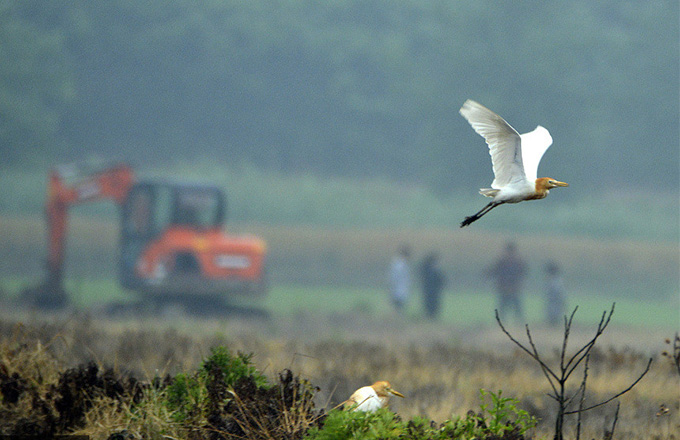Investigators hunt for clues to fire
Process of identifying the dead is continuing slowly, report He Na and Han Junhong in Dehui, Jilin province.
Police have cordoned off the road running up to the slaughterhouse in rural northeast China where the death toll climbed to 120 in a fire early on Monday morning.
Three checkpoints were set up at varying intervals along the road from Changchun, the capital of Jilin province, to the Baoyuanfeng Poultry Co in Dehui, where only a blackened, smoking shell remained of the huge workshop.
 |
|
Medical workers on Wednesday disinfect the site where a fire engulfed a slaughterhouse at a poultry factory, killing at least 120 people, in Dehui, Jilin province. [Photo/China Daily] |
Vehicles and pedestrians without permission to enter the area had to make detours to continue their journeys.
By mid-morning, several dozen relatives of the dead and severely injured had gathered on the road. Some were clearly agitated as they poured out their experiences during the past two days.
Most of the charred wreckage has been cleared from the smoldering ruins of the factory and staff from the Changchun Disease Control Center have disinfected the entire area with peracetic acid and quicklime.
The disinfection period will last three days, according to Wang Yanhui, director of the center.
Sources from the State Council Investigation Team said 395 workers were in the plant when the fire broke out. Seventeen are still missing, according to a report from China Central Television.
The fire, one of China's worst industrial disasters of recent years, swept through two workshops at the processing plant within minutes of a blast triggered by a suspected chemical leak, leaving 77 people injured, 15 of them in a critical condition.
Although many media reports have claimed the fire was caused by a leak of ammonia - which was used in the plant's cooling system - an investigation team from the State Council said the cause is still under investigation.
DNA tests
By Tuesday, only 67 of the dead had been identified and their bodies claimed by family members. DNA extraction work has almost finished on the bodies of those too badly disfigured to be identified by sight, according to a senior government official from Changchun, who declined to be named.
DNA has been taken from more than 100 direct relatives of presumed victims and investigation teams will soon begin the task of matching the samples with those of the deceased.
The plant is rectangular, about 400 meters long and consisted of two workshops. Almost all the survivors complained that the exits had been locked.
According to survivors, the two workshops were located in adjoining buildings and workers usually entered them via gates at the southern end. They said that as far as they knew, none of the workers who attempted to escape the inferno via the south gate had survived.
Many of the victims were couples, husband and wife teams who lived locally and worked together at the plant because its convenient location allowed them to remain close to their families. It's estimated that around 90 percent of those who lost their lives were women. The fire didn't just claim 120 lives - it also changed the destinies of their families.
A number of labor-intensive factories have been established in Dehui during recent years to stimulate the local economy. The plants attracted many young and middle-aged people, who otherwise would have headed to the coastal regions or large cities in their quest for work and a better life, according to Liu Yunbo, 44, who is being treated at Dehui Huikang Hospital.
Baoyuanfeng Poultry Co, which began operations in 2009, was the largest poultry firm in Dehui, employing more than 400 workers. However, discipline was said to have been draconian and employees were not allowed to leave their workstations without permission.
Inadequate materials
A safety inspection campaign has been carried out across Jilin province in the wake of Monday's disaster. A source from a meeting of Changchun's standing committee said the fire exposed the problems that exist in some labor-intensive enterprises. The source said fire control measures and fire exits at Baoyuanfeng Poultry Co existed in name only. Moreover, the company's workshops were constructed using combustible materials, which allowed the fire to spread at a deadly speed.
Liu Nan, a project manager at Baishun External Wall Factory, said that there are two common types of wall-construction panels; those that are flame retardant and those that are fireproof. In his experience, most of the labor-intensive factories in the province used the flame retardant panels for the sake of economy.
"It's much cheaper and can produce huge savings for companies that choose the cheaper option. Generally, the wholesale price for flame-retardant panels is about 240 yuan ($39) per square meter, while fireproof panels cost an extra 100 yuan per square meter," said Liu.
Customers generally buy a small number of fireproof panels that will pass muster when the authorities inspect the plants, he said.
Compensation
The work of arranging compensation for the injured and the families of the dead has not yet started. China Daily reporters have interviewed relatives of more than 20 victims and many injured during the past two days. None of them had been contacted by the authorities.
Yuan Yueping, 24, is receiving treatment at Dehui Fuyang Hospital after inhaling toxic fumes. He said he feels lucky to be alive and right now compensation is the last thing on his mind.
Many relatives of those who died are still too numb to consider the issue. Wang Yuli's 17-year-old sister was working at the poultry plant when the fire broke out. Nothing has been heard of her since. "My little sister is still missing and my mind is totally blank now," said Wang, the tears streaming down her cheeks.



















